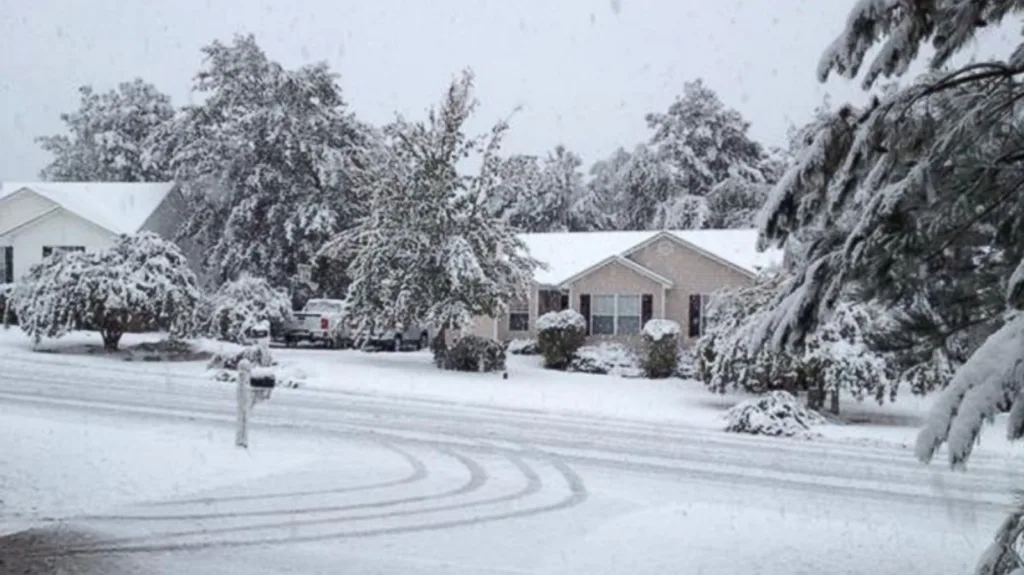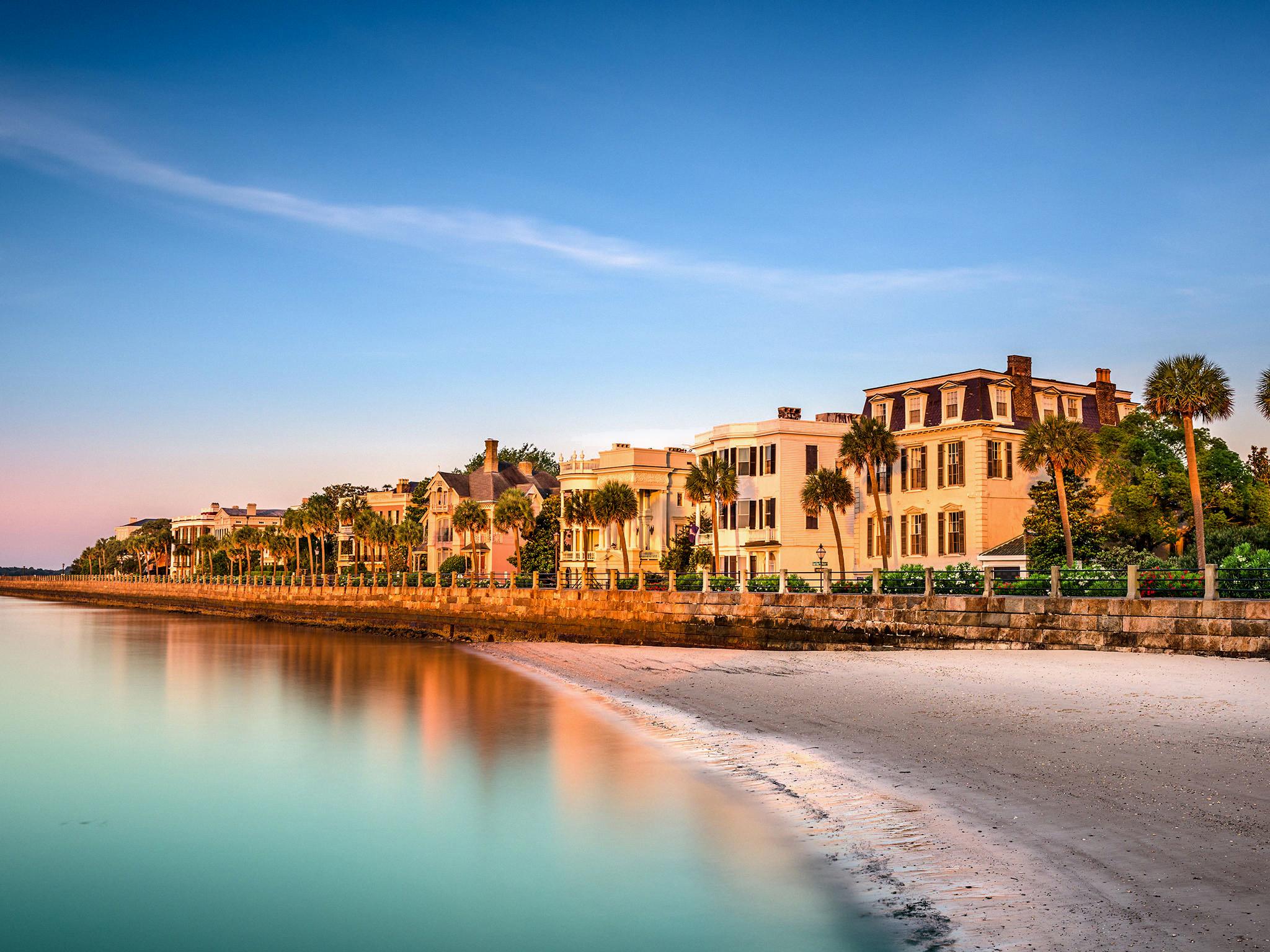Welcome to South Carolina, a state kown for its rich history, stunning beaches, and delicious cuisine. However, one question that many visitors and residents alike often wonder is, “does it snow in South Carolina?” The answer is yes, but it’s not a common occurrence.
South Carolina has a humid, sub-tropical climate, which means long, hot summers and short, mild winters. While snowfall is not a regular event in the state, it does happen from time to time. In the southern coastal area near and below Charleston, several years might pass without any measurable snowfall. However, in the Greenville, Spartanburg, and Anderson areas, total annual amounts range from 2 to 5 inches, with occasional annual totals reaching 8 or more inches.
The months of December to February are the peak of winter in South Carolina, and it’s during these months that you’re most likely to see snow. However, temperatures don’t absolutely plummet during these months, but you are more likely to see snow during this time.
It’s important to note that while snowfall in South Carolina is not common, it can still have a significant impact on the state. The lack of infrastructure to handle snow and ice means that even a small amount of snow can cause disruptions, including school and business closures, cancelled flights, and hazardous road conditions.
If you’re planning a trip to South Carolina during the winter months, it’s always best to be prepared for any weather conditions. Pack warm clothing and appropriate footwear, and keep an eye on weather forecasts in case of any unexpected snow or ice.
While snowfall is not a regular occurrence in South Carolina, it does happen from time to time. The state’s humid, sub-tropical climate means that winters are generally mild, but visitors and residents should always be prepared for any weather conditions. Whether you’re enjoying the beaches in Charleston or exploring the mountains in the northwest, South Carolina has plenty to offer year-round.
Areas of South Carolina That Receive Snowfall
South Carolina is generally known for its mild winter weather, and snowfall is a rare occurrence in most parts of the state. However, the areas of the state that are more likely to experience snowfall are located in the northwestern region, specifically in the Greenville, Spartanburg, and Anderson areas. On average, these areas receive between 2 to 5 inches of snow per year, with some years reaching up to 8 or more inches. In contrast, the southern coastal region, including Charleston, may go seeral years without any measurable snowfall. It’s important to note that while snowfall is not a common occurrence in South Carolina, it’s always wise to be prepared for inclement weather and follow any safety guidelines issued by local authorities.

Winter Weather in South Carolina
Winters in South Carolina are generally mild with temperatures averaging around 5 to 7°C (40 to 45°F) in inland areas and 12 to 15ºC (55 to 60°F) by the shore. The state has a humid, sub-tropical climate, so snowfall is rare, and the winter season is shorter than in many other parts of the United States. However, there are occasional cold snaps that can bring temperatures below freezing, particularly in the northern regions of the state. winter in South Carolina is generally comfortable, and residents and visitors can enjoy outdoor activities without having to bundle up in heavy winter clothing.
Snowfall in South Carolina During Winter Months
In South Carolina, snowfall is typically observed between the months of December and February. During this time, the state experiences its coldest temperatures, which can dip below freezing. Although snowstorms are not a regular occurrence in South Carolina, it is not uncommon for the state to receive a few inches of snow during the winter months. It’s important to note that the amount of snowfall and the duration of snow cover will vary from year to year and also depend on the location within the state. So, if you are planning to visit South Carolina during the winter months, it’s best to keep an eye on the weather forecast to stay prepared.
The Benefits of Visiting South Carolina in Winter
South Carolina can be a great destination during the winter months, especially in the eastern and southern portions of the state where mild temperatures prevail. The average winter temperature in these areas ranges from the mid-40s to the mid-60s, making it a comfortable time for outdoor activities such as hiking, biking, and golfing. However, in the northwestern regions of the state, temperatures can dip into the 30s and occasionally even into the 20s, bringing occasional snowfall and icy conditions. Despite this, many winter sports enthusiasts flock to the mountainous regions of the state for skiing, snowboarding, and oter winter sports activities. Additionally, South Carolina offers a variety of indoor attractions such as museums, art galleries, and cultural events that are perfect for colder days. South Carolina can be a great destination in the winter months for those who enjoy a mix of outdoor and indoor activities.
Comparing the Temperature of South Carolina and Florida
South Carolina is generally not hotter than Florida. While both states experience warm temperatures throughout the year, Florida teds to have a warmer and more humid climate overall. This is due to Florida’s more southerly location and its peninsula topography, which allows for warmer air to circulate around the state. Additionally, Florida is surrounded by warm ocean currents, which contribute to its overall warmer climate. In contrast, South Carolina has a more variable climate with cooler winters and milder summers. However, it should be noted that there may be variations in temperature within each state depending on the specific region and time of year.

Source: timeout.com
States Without Snow
There is only one state in the United States that typically does not experience snowfall during the winter season, and that is Florida. However, it is important to note that even in Florida, northern areas such as the panhandle may experience some light flurries during certan winters. In contrast, the remaining 49 states generally receive some amount of snowfall each winter season, with varying degrees of frequency and accumulation depending on their location and climate. Some states, such as Alaska, Maine, and Minnesota, are well-known for their heavy snowfall and harsh winter conditions, while others, like California and Arizona, may only experience snow in certain mountainous regions. snow is a common occurrence throughout much of the United States during the winter season.
The Low Cost of Housing in South Carolina
There are several factors that contribute to the affordability of houses in South Carolina. One of the most significant factors is the state’s relatively low tax burden. South Carolina is consistently ranked among the top 10 lowest taxed states in the US, whih means that residents can enjoy lower real estate taxes, sales tax, and personal income tax. This tax-friendly environment can make it more affordable for people to own property in the state.
Another reason why houses are cheap in South Carolina is the relatively low cost of living. Compared to other states, South Carolina has a lower cost of living index, which means that basic necessities such as food, healthcare, and transportation are more affordable. In particular, gas taxes are low in South Carolina, which means that the cost of transportation is significantly lower than in other states. This can make it easier for people to commute to work or travel around the state without breaking the bank.
Additionally, South Carolina has a relatively large supply of housing compared to its population. This means that there is less competition for housing, which can help keep prices down. Furthermore, the state’s economy is diverse and growing, which means that there are plenty of job opportunities and a stable housing market.
The combination of low taxes, low cost of living, and ample housing supply make South Carolina an attractive destination for those looking to purchase a home.
The Cost of Living in South Carolina
The cost of living in South Carolina is generally considered to be lower than the national average. In fact, it is estimated to be about 4% lower than the rest of the country. When it comes to housing, which is one of the biggest expenses for most people, South Carolina is particularly affordable, with costs estimated to be 15% lower than the national average. However, it’s worth noting that utilities in South Carolina are slightly higher than the national average, with a difference of about 9%. As for basic necessities like food and clothing, the cost of groceries in South Carolina is only slightly higher than the national average, with a difference of around 2%. Clothing costs are also estimated to be around 2% higher in South Carolina than in othr parts of the country. while there are some variations in costs depending on the category, South Carolina is generally considered to be an affordable place to live.
The Benefits of Living in South Carolina
South Carolina is a great place to live for many reasons. Firstly, it has one of the lowest crime rates in the country, making it a safe environment to raise a family. The state also has a strong economy, with many job opportunities and low unemployment rates in major cities such as Charleston, Columbia, and Greenville. Furthermore, South Carolina is kown for its beautiful natural scenery, with picturesque beaches, mountains, and forests. Additionally, the state has a rich cultural history and offers a variety of activities such as museums, festivals, and outdoor recreation. South Carolina is a wonderful place to call home due to its safety, economy, natural beauty, and culture.

Does Myrtle Beach Experience Snow?
Myrtle Beach does receive snow, but it is a rare occurrence. On average, the area receives less than 1 inch of snow per year. This is due to the city’s location in the southeastern United States, where the climate is typically mild and winters are relatively short. However, when snow does fall in Myrtle Beach, it can create a beautiful and unique sight for residents and visitors to enjoy. Despite the infrequency of snow, it is still important for locals and tourists alike to be prepared for winter weather conditions, including icy roads and sidewalks.
Average Winter Temperatures in South Carolina
Winter seasons in South Carolina are generally mild, with average daily temperatures ranging from 47° F (8.3° C) to 52° F (11.1° C). While temperatures can drop below freezing, the region typically experiences its first freeze in early December and the last freeze in late February. There is also a slight chance of snow flurries in late December and early January, but overall, winters in South Carolina are characterized by periods of rain rather than heavy snowfall.
Has Snowfall Ever Occurred in Florida?
It has snowed in Florida before. However, it is a rare occurrence, as the state’s subtropical climate is not conducive to snowfall. Snow is most likely to occur in the northern and central parts of Florida during a strong winter storm. In January 2010, an Arctic cold front brought light snow to parts of central Florida, including Tampa, Orlando, and Melbourne. Typically, Florida only receives freezing rain or sleet during winter storms.
Comparing the Temperature of North and South Carolina
When it comes to comparing the temperatures in North and South Carolina, it’s important to note that both states experience seasonal changes in climate. However, on average, North Carolina tends to be slightly cooler than South Carolina. This is primarily due to North Carolina being located further north, which results in cooler temperatures during the winter months. Additionally, North Carolina also has a higher elevation in some areas such as the Appalachian Mountains, which can contribute to cooler temperatures. That being said, both states still have mild winters overall with temperatures rarely dropping below freezing. Ultimately, the temperature difference beteen North and South Carolina is relatively minor and shouldn’t have a significant impact on travel plans or outdoor activities.

Source: visittheusa.com
Comparing the Average Temperature in North Carolina and South Carolina
When it comes to the temperature difference between North Carolina and South Carolina, there are a few factors to consider. Generally speaking, the northern parts of North Carolina can experience cooler temperatures than the southernmost region of South Carolina. However, the most significant temperature differences in the Carolinas are due to the varying climate between the eastern coastal regions and the western mountainous regions. The coastal areas of both states experience milder temperatures due to the moderating effects of the ocean, whreas the western parts of both states, particularly the mountainous regions, experience cooler temperatures due to their higher elevations. the temperature difference between North Carolina and South Carolina may vary depending on the specific location and time of year.
Does South Carolina Experience Four Seasons?
South Carolina does have four distinct seasons. These seasons are characterized by their own unique weather patterns, temperatures, and natural phenomena. In the winter months, South Carolina experiences cooler temperatures and occasional snowfall, whih typically lasts for a short period of time. Spring brings warmer temperatures and the blooming of flowers and trees such as Dogwoods, Azaleas, and Yellow Jessamine. Summer is characterized by hot and humid weather, with average temperatures reaching into the high 80s and 90s. Fall brings cooler temperatures and the changing colors of leaves on trees such as Oak and Maple. South Carolina’s four seasons offer a diverse range of natural beauty and outdoor activities to enjoy throughout the year.
Conclusion
South Carolina boasts a humid, subtropical climate that is characterized by hot summers and mild winters, with occasional snowfall in certain areas. The state experiences pleasant springs and autumns, making it an ideal destination for outdoor activities and sightseeing during these seasons. While the coastal regions rarely see any snowfall, the inland areas may receive up to 8 inches annually. South Carolina is a beautiful state with a diverse climate that offers something for everyone, from beaches and historic sites to mountains and forests.
